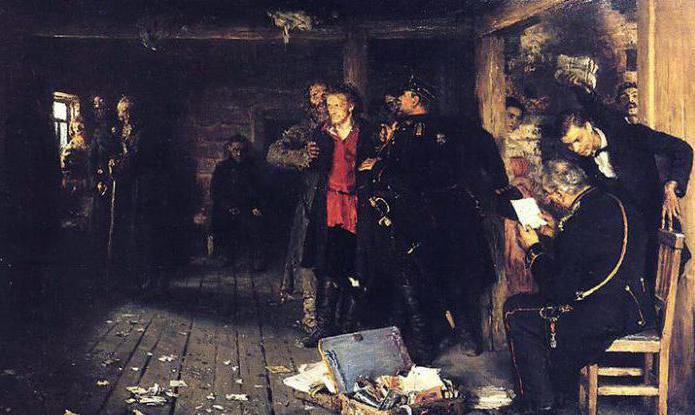“Walking in the people” is a phenomenon that has no analogues in any country in the world. Agrarian Russia was not shaken by bourgeois revolutions. The best representatives of the nobility rose against autocracy and serfdom. The peasants received freedom under the reform of 1861, which was half-hearted, which caused their discontent. Diversites took the revolutionary baton, believing in the possibility of achieving socialism through a peasant uprising. The article is devoted to the progressive intelligentsia movement for enlightenment and revolutionary propaganda among the people.
Background
Young people from the middle class were drawn to education, but the fall of 1861 was marked by an increase in tuition. Mutual help desks were also banned, helping poor students. Unrest began, brutally suppressed by the authorities. Activists not only were expelled from universities, but also turned out to be thrown out of life, as they were not taken to public service. A.I. Herzen called the victims "exiles of science." In the journal Bell published abroad, he invited them to go "to the people."
So spontaneously began "going to the people." This movement grew into a mass movement in the early 70's, gaining particular momentum in the summer of 1874. The appeal was supported by revolutionary theorist P.L. Lavrov. In his "Historical Letters" he expressed the idea of the need to "pay the debt to the people."
Ideological inspirers
By that time, a utopian idea was formed in Russia about the possibility of a peasant revolution, the victory of which would lead to socialism. Her followers were called Narodniks, for they spoke of a special path for the development of the country, idealizing the peasant community. The reasons for "going to the people" lie in the unconditional belief of the raznochintsy in the correctness of this theory. Three trends were distinguished in revolutionary ideology (the scheme is presented a little higher).
Anarchist M.A. Bakunin believed that the people were ready for rebellion and that there was enough appeal for the peasants to take up the forks. P.L. Lavrov suggested that the “critically thinking” representatives of the intelligentsia first help the people (peasants) realize their mission, and then jointly create history. Only P. N. Tkachev argued that the revolution should be carried out by professional revolutionaries for the people, but without his participation.
The “going to the people” of the Narodniks began under the ideological leadership of Bakunin and Lavrov, when the first associations had already been created — the Moscow and St. Petersburg circles of N. V. Tchaikovsky and the “Kiev Commune”.
Basic goals
Thousands of propagandists traveled to remote villages disguised as merchants and artisans dressed as artisans. They believed that their costumes would inspire the confidence of the peasants. They carried books and propaganda appeals with them. Thirty-seven provinces were captured by the movement, especially actively - Saratov, Kiev and Verkhnevolzhskaya. The triune goal of “going to the people” included the following points:
- The study of peasant sentiment.
- Propaganda of socialist ideas.
- The organization of the uprising.
The first stage (until the middle of 1874) is called "flying propaganda", because the revolutionaries, relying on their strong legs, moved from one settlement to another, without delaying for long. In the 2nd half of the 70s, the second stage began - "settled propaganda." Populists settled in villages, acting as doctors, teachers or artisans, specially mastering the necessary skills.
results
Instead of supporting the revolutionaries met with mistrust. Even in the Lower Volga region, where the traditions of Emelyan Pugachev and Stepan Razin should be alive. The peasants willingly listened to speeches about the need to divide landowner land and abolish taxes, but as soon as it came to calls for rebellion, interest faded. The only real attempt at the uprising was the Chigirinsky Conspiracy of 1877, brutally suppressed by the autocracy. Often the villagers themselves turned in the gendarmerie propagandists. For six years, 2564 people were involved in the inquiry.

The painting by I. Repin of 1880 captures the moment of the arrest of a propagandist in a peasant hut. The main evidence is a suitcase with literature. The picture clearly shows how the "going to the people" ended. This led to massive repression. The most active were convicted in St. Petersburg in 1878. The court went down in history as the “Process of One Hundred and Ninety-Three,” in which about a hundred people were sentenced to exile and hard labor.
Historical meaning
Why did the revolutionary youth movement fail? Among the main reasons should be called:
- The unpreparedness of the peasantry for a revolutionary coup.
- Lack of communication and general leadership.
- The ferocity of the police.
- The lack of conspiracy skills among propagandists.
What conclusion did unsuccessful “going to the people” lead to? This can be understood from subsequent historical events. A massive departure from Bakunism and the search for new forms of political struggle began. There was a need for a single all-Russian organization on the basis of the strictest conspiracy. It will be created in 1876 and in 2 years it will go down in history under the name “Earth and Will”.